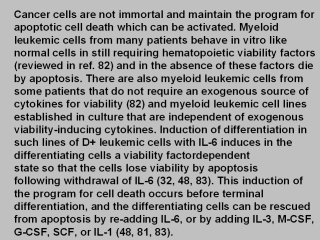 |
The differentiating leukemic cells can also be
rescued from apoptosis by the tumor promoting phorbol ester
12-0-tetradecanoylphorbol 13-acetate (TPA) but not by the nonpromoting
isomer 4-α-TPA (32). TPA rescues the
differentiating cells from apoptosis by a different pathway than rescue with
these cytokines. TPA can thus act as a tumor promoter by inhibiting
apoptosis (32). It is therefore possible to activate the normal
physiological process of apoptosis in myeloid leukemic cells, and this can
be used to suppress leukemia even without induction of terminal
differentiation. This has been shown by the decreased in vivo
leukemogenicity of IL-6-pretreated leukemic cells with a viability
factordependent state (83) and by the ability of antibody to IL-6 or to its
receptor to suppress the development of multiple myeloma by IL-6-dependent
myeloma cells (84, 85).
|
